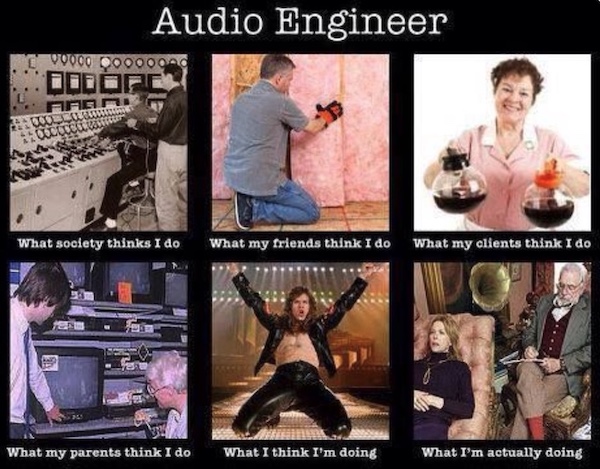May 26th, 2021 - Category: Apple
Before becoming a technical writer, I spent years working in the field of industrial acoustics. When non-technical people found out that I was an acoustic engineer they would often ask: “Cool! What bands have you worked with?” or “You must have an amazing stereo system!”
Like the joke in the image below, the truth was much more mundane, the acoustics I worked with mostly involved analyzing sound to reduce the level or modify its properties. For example, improving cell phone acoustics, reducing machinery noise, or tailoring the sound of a product to make it more appealing. It was like the old, solid Mercedes door slam sound that people equated with quality, but Hyundai wanted to copy at much lower cost.

As a result, many of the problems I worked on were related to how humans subjectively perceive sound. A washing machine needs to be “quiet,” but quiet is perceived differently in the US versus Asia, in a small apartment versus a large home, and if the load is unbalanced, it should make an appropriate noise to alert the user. For music, this subjectivity varies hugely. A focused listener of classical music has very different expectations of level and quality than distracted people listening to music while they work, commute, or enjoy a drink in a bar. Even in industrial acoustics, engineers often asked me, “I can hear there’s a problem, why can’t we measure it?” Ah, the magic of the human ear / brain system! We can understand a conversation despite being in a noisy room, still watch a movie with picture issues but stop watching if the audio is bad, and hear the quietest rustle of leaves as well as enjoying a loud rock concert (a range of sound pressure that spans 1,000,000:1 on this sound level chart).
As for my “amazing stereo system” I prefer a decent pair of headphones or a bluetooth speaker and many of my colleagues did as well. It was a case of knowing too much for our own good. What use are $500 (or $50,000) speakers when the room isn’t optimized for listening, the music isn’t recorded correctly, etc. So when I read “Apple will bring Lossless Audio to their entire catalog,” my engineering skepticism was triggered. Soon after, I came across the Reddit thread (with 700+ comments), “How Well Can You Hear Audio Quality?” and I clicked on the link to the NPR article which turned out to be from 2015.
 This is obviously not a new issue. Despite using my best headphones, connected via a physical wire to a nice amplifier, I couldn’t tell the difference between the lossless and MP3 versions of the music. My hearing is excellent, I know what to listen for, I was completely focused on the test, but there was no major improvement in the lossless versions that I could discern. It reminded me of an article I wrote back in 2014, “The Technology and ‘Soft Science’ of 3D Sound” which in turn was based on a New Yorker article, “The Quest for 3-D Recording…” Seven years later, 3-D sound is still just beginning to gain acceptance.
This is obviously not a new issue. Despite using my best headphones, connected via a physical wire to a nice amplifier, I couldn’t tell the difference between the lossless and MP3 versions of the music. My hearing is excellent, I know what to listen for, I was completely focused on the test, but there was no major improvement in the lossless versions that I could discern. It reminded me of an article I wrote back in 2014, “The Technology and ‘Soft Science’ of 3D Sound” which in turn was based on a New Yorker article, “The Quest for 3-D Recording…” Seven years later, 3-D sound is still just beginning to gain acceptance.
Are these developments a real step forward for the reproduction of music or is it just another example of technological snake oil? I’m certainly not dismissing them as irrelevant, especially since in 1916 listeners to Edison’s “revolutionary” phonograph felt like they couldn’t tell the difference between those first very “lo-fi” recordings and the orchestra playing behind the curtain. Maybe in the near future, people will feel the same way about MP3s as we feel about old 75 RPM records? Only time will tell.
There are all interesting questions that don’t, and may never, have answers. The one thing for sure is that it will all change again in a few years. “Holographic music” anyone?